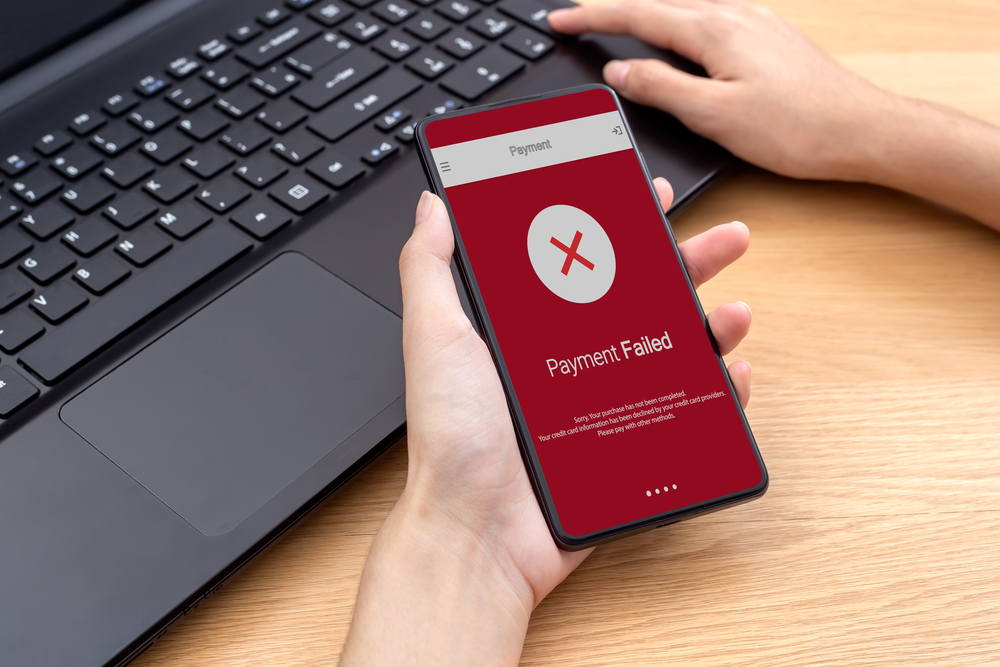
- CHECKOUT
- CREDIT CARD DECLINES
- CREDIT CARD PAYMENTS
- CREDIT CARD PROCESSING
- Credit Card Processing Fees
- PAYMENT PROCESSING
- RISK
The Rising Problem of Credit Card Declines: #1 Cause and Solutions for Merchants
Mar 10, 2023 3 minutes
Since the dawn of technology, credit cards have been a revolutionary payment method—providing unprecedented convenience and trust in online commerce.
Nowadays, this simple yet powerful tool has become ubiquitous as an ever-popular means of transaction for shoppers worldwide. However, merchants are finding that their transactions are increasingly subject to declines from customers’ issuing banks due to reasons beyond the merchant’s control.
This rising problem results in lost sales and customer dissatisfaction for merchants on all levels. In this article, we’ll explore why credit card declines occur, the effect on businesses, and strategies you can use to help reduce these incidents and avoid potential losses.
The #1 Cause of Credit Card Declines Is Insufficient Funds
When a customer attempts to make a purchase with a credit card, the card issuer performs a credit check to ensure that the customer has enough available funds to cover the transaction. If the customer’s available credit limit is not sufficient to cover the purchase, the issuing bank will decline the transaction.
Not only does this result in a declined transaction for the customer, but it also results in a lost sale for the merchant. Moreover, the merchant also incurs a payment processing fee for the declined transaction, resulting in a further loss of revenue.
Fee-Free Overdrafts Hurt Merchants
Most banks and financial institutions offer fee-free overdrafts for account holders. That’s great for consumers who hover over the $0 line or live paycheck-to-paycheck, but it sucks for merchants. This convenience discards the fear consumers should have about spending money they don’t have, giving them the confidence to keep shopping.
You can’t reverse the bank’s decision, but you can inform your customers about overspending prior to completing checkout. One way might be to encourage your customers to contact the credit card issuer to confirm their credit limit and, if necessary, to increase their limit before they attempt to make a purchase.
Decline Message in Your Gateway
It’s important to ensure that your payment gateway is up-to-date with the latest security protocols and check for any decline codes that may appear when a customer attempts to make a purchase with a credit card.
Every credit card decline is linked to a code, reason, or message any merchant can find in their gateway. Use this to your advantage and see which declined credit card codes appear most often so you can work to mitigate the fees you, as the merchant, have to pay while smoothing out the customer experience.
More declines than normal? We can help.
Declined Transactions’ Impact on Merchants
Merchants still pay a fee even if a transaction is declined. You should aim to mitigate any repeating declines you see on your payment gateway or processor because you are the one that suffers.
Below are the top ways merchants are impacted by insufficient funds declines:
- Lost sales revenue: A declined transaction means that the merchant does not receive payment for the goods or services they have provided. This can result in lost sales revenue and reduced profits.
- Transaction fees: Merchants may still be charged transaction fees even if the payment is declined. This can increase the cost of doing business and further reduce profits.
- Time and effort: Processing a transaction takes time and effort on the part of the merchant. A declined transaction means that this time and effort has been wasted, which can be frustrating for the merchant.
- Negative customer experience: If a customer’s credit card payment is declined, they may be embarrassed or frustrated. This can lead to a negative customer experience, which can hurt the merchant’s reputation and lead to lost future sales.
- Payment disputes: If a customer’s payment is declined, they may dispute the charge with their bank or credit card company. This can result in chargebacks, which can be costly and time-consuming for the merchant to resolve.
- Cash flow problems: If a business owner relies on regular sales to maintain cash flow, a high rate of declined transactions can lead to cash flow problems. This can make it difficult to pay bills, make payroll, or invest in the e-commerce business.
- Fraud prevention measures: To reduce the risk of declined transactions due to insufficient funds, merchants may need to invest in fraud prevention measures. This can include additional staff, software, or hardware, which can be costly.
- Decreased approval rate: Declined transactions are seen as a sign of risk and may result in the merchant either being labeled as high-risk by the payment processor or increasing their risk profile if they are already operating in a high-risk industry.
Overall, merchants should be aware of the impact that declined transactions can have on their business. By understanding the consequences and taking steps to reduce declined transactions, merchants can help protect their bottom line and keep their customers satisfied.
Understanding the Consumer Perspective
Understanding the consumer perspective is essential for any merchant seeking to maintain a successful business. The reasons for credit card declines are often beyond the merchant’s control and can cause confusion and frustration for shoppers.
Merchants need to be aware of the possible causes of credit card declines, such as insufficient funds, changes in the cardholder’s account, or expired cards. Understanding the customer’s individual experience can help merchants take proactive steps to reduce the number of declined transactions.
It is also important for merchants to understand the impact of declined transactions on their customers. For example, merchants must be aware of the decline message they are sending to customers and the credit card processing fees associated with declined transactions. Additionally, knowing the best practices for handling declined transactions can help merchants ensure customer satisfaction and keep transactions running smoothly.
It is important to have a customer-focused mindset when dealing with declined transactions to ensure the customer’s experience is positive, even when their transaction is declined.
Is your checkout customer-friendly? Let’s take a look.
Solutions for Merchants to Help Reduce Insufficient Funds Declines
Merchants need a solution ASAP. Here are a few you can implement now to save your business from drowning in fees or losing customers because they can’t afford your product.
Implement Pre-Authorization
Merchants can use pre-authorization to check if a customer’s form of payment has sufficient funds before the transaction process reaches the card network. This can help reduce the number of declined transactions due to insufficient funds and there’s no harm to the customer. They simply receive a message asking to retry with a different card.
Offer Alternative Payment Methods
Merchants can offer customers alternative payment methods, such as PayPal, Venmo, ACH, debit cards, or digital wallets. These payment methods may have lower transaction fees and may be more convenient for customers.
Set Up Automatic Billing
Merchants can set up automatic billing for customers with recurring payments. This can help reduce the risk of declined transactions due to insufficient funds and ensure that payments are received on time.
Offer a Discount
Making a sale is better than losing one. Take a slight loss in revenue and offer customers who get their credit card transactions denied due to insufficient funds a discount code of 50%. Merchants will still make the sale, customer will get the products they want, and the relationship will remain strong.
Review Pricing and Fees
Merchants can review their pricing and fees to ensure that they are competitive and reasonable. This can help reduce the number of declined transactions due to customers not having enough funds to make a purchase.
Work with Payment Processors
Merchants can work with their payment processors to understand why declines are happening and to implement solutions to reduce the number of declined transactions. Depending on the relationship you have with your processor, you can request to remove any fees incurred on declines.
Monitor Payment Trends
Merchants can monitor payment trends to identify any patterns or issues that may be causing an increase in declined transactions due to insufficient funds. This can help them proactively address the issue and reduce the impact on their small business.
Additional Recommendations
Merchants should also consider implementing fraud prevention measures such as AVS (Address Verification System), CVV, or 3D Secure protocols for added security. These protocols allow merchants to verify the customer’s identity by matching the customer’s billing address, zip code, and other card information with their credit card number.
Payment gateways are quite powerful. Merchants can set up a pre-auth check for payments made with Mastercard and Visa, specifically. Or if they see a trend of declines for American Express or Discover, offer coupons to customers in your database who frequently use those types of cards.
Stop suffering from declines. Let’s make your business profitable again.
Implement the solutions outlined above to help reduce the number of declined transactions due to insufficient funds. These solutions can help merchants save money, improve customer satisfaction, and keep their businesses running smoothly.
If you need to lower your transaction fees due to declines, DirectPayNet can help. We will set you up with a merchant account and link you with a payment processor that allows you to negotiate fees as well as support your business. Contact us today to get started.




